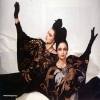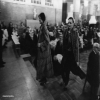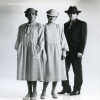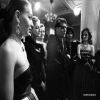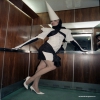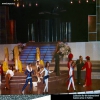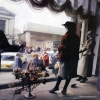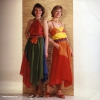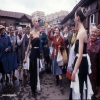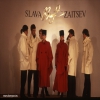
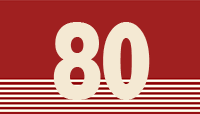
Soviet couture
|
Houses of fashion existed in all republics and cities of the Union, and were counted by dozens already in the postwar period. But in 1969, houses of fashion, studios and factories moved to the Ministry of public services and a gradual fading of this industry began. At each house there was a fashion propaganda department, who led the fashion theater, inspiring people to a certain taste through fashion shows. Despite the unenviable role of these institutions there were great masters, able to not only impress the customer, but also to maintain the prestige of the country, as it was at the Montreal World Exhibition in 1967, when Tatiana Kozeeva from Kiev was elected as "Miss Montreal", and her photo graced the covers of Canadian magazines and the whole world was swept by the short-term fashion for "Russian". The main flagships of "propaganda fashion" were considered the Obshesoyuzniy, Tallinn, Riga and Kiev houses of fashion, the rest were significantly on different levels. The Leningrad house of fashion, by the nature of the city and the production was mostly oriented on the theater, and it left a definite imprint on the style that developed in these conditions. In Moscow, in addition to Moscow and Obshesoyuzniy House of models existed a house of sporting fashion, knitwear, youth fashion house in Sokolniki and the Bureau of industrial clothing, to which was assigned the duty of technological innovations on the cut, cloths and equipment for factories. In general, it turned out that all work was at the level of ideas and confirmation of the existence of some kind of illusion of domestic fashion. It could be seen, the nomenclature could order it, but could not buy it, not only domestic citizens but also foreigners, who faced the remarkable specimens during a brief visit and fell in an inextricable situation where they could not buy anything with foreign currency. At the same time at the factories and fashion houses a team was working, part for the idea, part by the virtue of the appeal of the aura of belonging to the world of fashion. The work of "fashion models" and "demonstrators of outerwear" was rather poorly paid, but the girls acted as actresses on tours and shows, moreover, in the late 1970’s, models were also let not only to the Soviet bloc countries, but also to Mexico and Japan. The work of fashion designers was determined by the word "standards", each had to develop a certain amount. From the choice of the artistic council a promising, as it was called, collection was formed, which then was adapted to the factories. What is remembered with a shudder the authors of costumes and chief art critic Irina Andreeva, who worked in those days in ODMO, recently published a collection of her memoirs "Notes of a Soviet citizen" about the twists and turns of Soviet fashion. In 1982 at the Moscow House of Fashion, in the late 80's appears the Fashion Theatre of Vyacheslav Zaitsev, who shortened his name to the brief Slava. That was the first case, when a house got a fashion designers name and the clothes got the masters name. In this fashion house, as in any other, were developed and produce models that were not threatened to go into mass circulation. Although the models were developed by wonderful designers, and covered many areas, as befits the fashion industry. And the models in the fashion house at the Kuznetsk 14 were divided by different categories of the population – there was fashion for the young, for the adults, and big sizes. By the mid-80’s, in addition to male and female lines appeared the youth fashion which was frankly copied from foreign magazines. Soviet designers who sharpened their talents over the years by adapting national segments, simply did not have sufficient knowledge in this area. Something reached through information from the Soviet bloc, from the Polish black and white youth magazines "Kobetta I zhiche" or the colored one from Yugoslavia «Bravo». The production of clothing still rested on the ability of private persons that could reproduce all this from available tools and publicized thousands of times patterns. Fashion houses produced a small amount of finished product merchandise for shows and photo shoots for the, which was almost impossible to buy not only ordinary citizens but also for the employees of the house. But still Zaitsevs models, in the first half of the 80’s were actively involved in promoting the products of the key jewelry partner of the USSR, Czech concern "Yabloneks". But the finest hour for the maestro came only with the beginning of perestroika, when he was able to demonstrate 120 models in the framework of an agreement with Intertorg, and in 1989 was proclaimed as the Maison de Couture (person of the year in the fashion world) in Paris. In 1988 appears "Vali Moda" from young Valentin Yudashkin, at a time as the Moscow House of Fashion becomes the House of Fashion Slava Zaitsev. All of these changes were largely associated with the figure of Raisa Gorbacheva, who at the dawn of perestroika took the bear to change the situation that she has partly succeeded. Raisa who closely followed the fashion world and became the first Soviet lady ordered things in ODMO and changed the existing tradition before placing such orders to KDMO (Kiev union house of models). Gorbacheva met Cardin and Laurent, after that the last staged a show in Leningrad in 1986, and Zaitsev in Vancouver, and then in Germany for the promotion of the company Salamander, which in 1987 opened a joint venture on the basis of the Leningrad factory "Proletarskaya pobeda". Because of the figure of Raisa happened not only the emergence to the Soviet Union of the magazine "Burda", but also less known facts. Such as private screenings of the "princess of fashion" Princess Galitsina, whois specially prepared a collection in 1988 and did two shows - in the Old Circus and the Palace of Congresses. Fashion models from Kuznetsk 14 were invited directly to political party conferences. The First Lady's image was created by the efforts of fashion designer Tamara Mokeeva. Raisa Gorbacheva, ordering from Irina Krutikova a fitted black coat from carakulcha instantly made it the trend of the season, and made fashionable of a Cuban cap. This, of course, affected the interest the Soviet subject, and multiplied by the shock of the alternative insider stories, the interest grew so much that Thierry Mugler started to photograph models with the background of Soviet architecture, Jean-Paul Gaultier made a collection in a constructive spirit with the use of Cyrillic fonts, and Yves Saint Laurent at this time dressed his models in carakul hats in the style of general secretaries. Following a series of beauty competitions, computerized shops of finished products in the Fashion Center Luks were opened, where (to quote the magazine Stern, 1988), visitors were trying to talk to mannequins and shop assistants did not always cope with the new technology at the checkout. A store of finished products in ODMO opened, new journals "Kuznetsky Most" and "Models of the season" were published, and the previously nameless things found their names: Tamara Mokeeva, Tatyana Parfenova, Natalia Orsk, Lydia Soselia, Alexander Ingmand. Independent actions based on fashion and author's costume flourished not only in the capitals, but also in areas remote from the city center. For example, in a town called Shahti, was held an annual fashion festival. Modeling agencies were being opened, the most famous of which was the agency "Firebird", for the first time in Moscow in 1989 the "British Fashion Week" was held, and American brands already prepared marketing schemes for opening their own productions, the first boutiques of Pierre Cardin, Nina Ricci were opened, but ... The population, who shifted to the west, were first covered by a wave of co-operative consumer goods, and soon drowned in an even more powerful wave of tons of Chinese-Polish fakes imported by "shuttle traders". The new trendsetters in crimson colored jackets a la Versace and tracksuits ended the final hope to gain a foothold in the market to open private houses and studios until the mid-90’s. But it is worth noting that even then there was a great demand for Russian models abroad, like Natalia Semanova, Ludmila Isayeva, Tatiana Sorokko - this is an incomplete list of names with who abroad linked to the theme of Russian beauty in the 1990’s. The topic of high Russian fashion abroad was still associated with the "Red Dior", Zaitsev and Russian furs. The direction firmly connected with the name of Irina Krutikova, who developes the "golden fur" technology since the mid-80’s, models of which were shown abroad only in the early 1990’s as a collection called "Birds".  go back to "Fashion" go back to "Fashion" |

